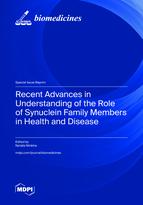Recent Advances in Understanding of the Role of Synuclein Family Members in Health and Disease
A special issue of Biomedicines (ISSN 2227-9059). This special issue belongs to the section "Neurobiology and Clinical Neuroscience".
Deadline for manuscript submissions: closed (31 December 2022) | Viewed by 24712
Special Issue Editor
Interests: neorodegeneration; mechanisms of proteinopaty; synuclein family; physiological functions of synucleins; chemical neurotransmission; dopamine; synucleinsynuclein-associated pathology
Special Issue Information
Dear Colleagues,
Extensive studies of α-synuclein function and dysfunction revealed its involvement in multiple normal and aberrant molecular processes and consequently, various effects on the nervous system cell biology. However, certain other types of cells normally express this protein, and they may also be affected by α-synuclein dysfunction and thus contribute to pathological changes in α-synucleinopathies. It would be beneficial to summarise scattered data on these aspects of α-synuclein biology and pathology. Recent studies draw attention to the other two members of the family, b-synuclein and g-synuclein, whose role in homeostasis and pathology is still poorly understood. Three members of the family share many structural properties and have an overlapping pattern of expression and intracellular distribution in the developing and adult nervous system, which point to functional redundancy within the family. However, each synuclein has its own functions unshared with two other synucleins and in some cellular mechanisms and pathways, these functions could be antagonistic rather than synergistic.
This Special Issue aims to highlight the most recent research on both already well-known and emerging aspects of synuclein family biology and the role of the dysfunction of these proteins in neurodegenerative and other pathological conditions.
Dr. Natalia Ninkina
Guest Editor
Manuscript Submission Information
Manuscripts should be submitted online at www.mdpi.com by registering and logging in to this website. Once you are registered, click here to go to the submission form. Manuscripts can be submitted until the deadline. All submissions that pass pre-check are peer-reviewed. Accepted papers will be published continuously in the journal (as soon as accepted) and will be listed together on the special issue website. Research articles, review articles as well as short communications are invited. For planned papers, a title and short abstract (about 100 words) can be sent to the Editorial Office for announcement on this website.
Submitted manuscripts should not have been published previously, nor be under consideration for publication elsewhere (except conference proceedings papers). All manuscripts are thoroughly refereed through a single-blind peer-review process. A guide for authors and other relevant information for submission of manuscripts is available on the Instructions for Authors page. Biomedicines is an international peer-reviewed open access monthly journal published by MDPI.
Please visit the Instructions for Authors page before submitting a manuscript. The Article Processing Charge (APC) for publication in this open access journal is 2600 CHF (Swiss Francs). Submitted papers should be well formatted and use good English. Authors may use MDPI's English editing service prior to publication or during author revisions.
Keywords
- synuclein family
- alpha-synuclein
- beta-synuclein
- gamma-synuclein
- physiological functions of synucleins
- synucleins and lipids
- function of synucleins outside of the nervous system
- synuclein-associated pathology







